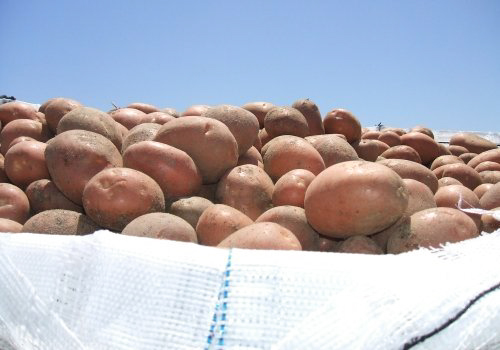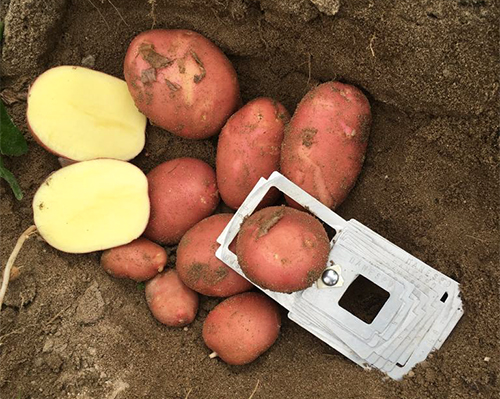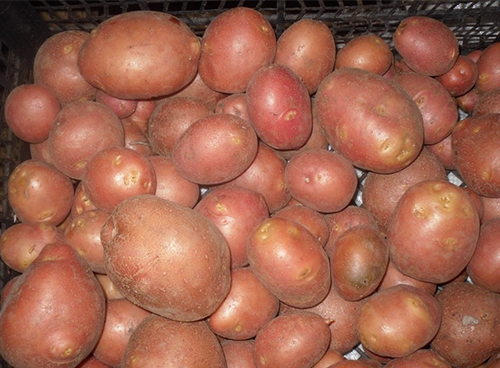Bellarosa potato variety
Bellarosa is an early ripening potato variety (Solanum tuberosum). Received by employees of the German plant breeding company Europlant Pflanzenzucht GmbH (Luneburg). Entered into the state register of Russia in 2006, into the register of Ukraine - in 2004. Zoned in four regions of the Russian Federation: North-West (Vologda, Kaliningrad, Kostroma, Leningrad, Novgorod, Pskov, Tver and Yaroslavl regions), Volgo-Vyatsky (Kirov , Sverdlovsk and Nizhny Novgorod regions; Republics of Mari El, Udmurt and Chuvash; Perm Territory), Central Chernozem (Belgorod, Voronezh, Kursk, Lipetsk, Oryol and Tambov regions) and Ural (Republic of Bashkortostan; Kurgan, Orenburg and Chelyabinsk regions).

Ripening period 50 - 70 days. However, the first digging can be carried out already on the 45th day from the appearance of full shoots. In warm regions, you can get two harvests in one season. Bellarose bushes can be undermined without damaging the plants.
Plants are erect, tall (70 - 75 cm), intermediate type. The leaves are green, large, closed. The edge of the leaf plate is slightly wavy. Corolla of medium size red-violet color. Due to the fact that Bellarosa gives an early harvest, flowering is weak or absent at the time of digging. Therefore, if your potatoes are not blooming, do not worry - this is normal for this variety.

Tubers are aligned, oval-round, large and medium in size. The eyes are shallow, the depth is medium or shallow. The peel is red, slightly rough. The pulp is light yellow, slightly dryish. The mass of a commercial tuber is 120 - 210 grams, some specimens reach 800 - 1000 grams. The average number of tubers in a nest is 8-10.
The yield of commercial tubers is 169 - 326 c / ha, which is 26 - 63 c / ha higher than that of the standard variety Nevsky... Productivity on the 45th day after full germination (first digging) - 143 - 277 c / ha, which is 34 - 155 c / ha higher than the standard Zhukovsky early, on the 55th day (second digging) - 170 - 385 c / ha, which is 56 - 231 c / ha higher than the standard. The maximum yield is 385 c / ha, which is 231 c / ha higher than that of the Zhukovsky early standard (data for the Tambov region).

A variety for table use, with high taste properties (it tastes better after storage). Great for frying, making chips and French fries. Boiled tubers are crumbly, but do not fall apart during cooking. Darkening after cooking is negligible. Starch content - 12 - 16%. Bellarosa is stored very well in comparison with other early varieties - up to the month of May.
This potato is characterized by high resistance to the causative agent of potato cancer, golden potato cyst nematode, leaf roll virus, common scab and black leg. It is also resistant to drought, high temperatures, damage and sprouting of tubers. Resistance to brown spot and late blight is average.
Before planting, it is advisable to germinate the tubers, as well as to pickle from rhizoctonia. Tubers stimulated to sprout can be planted early. Unprepared tubers can only be planted when the soil warms up above 8 ° C. To grow large tubers, the bushes are placed at a distance of 30 cm, the row spacing should be 75 cm; to obtain medium-sized tubers, the bushes are placed even closer. It is worth noting that you can plant with cut tubers, leaving at least 1 - 2 eyes in half.
Plants are unpretentious to the soil, they perfectly adapt to various climatic and environmental conditions, but, of course, respond well to fertilization and watering.
Advantages of Bellarose potatoes: high taste, ultra-early ripening of the crop, plasticity, unpretentiousness, resistance to diseases and degeneration, good transportability of tubers, high marketability (82 - 99%), keeping quality (93%) and yield.
The disadvantages include a strong susceptibility to late blight during prolonged rains, as well as the fact that the tubers grow non-compactly and are easily damaged when digging.
Due to the deep red color of the peel, the people call this variety "Cherry".









I have been growing this variety for more than one year. The question of whether to leave him in his household or not never arose. He proved himself the first time and has never let me down. Of course, there is no year after year. In the best years Bellarosa gives a very good harvest, and in the worst it is just good.
The pulp is yellow in color, making the mashed potatoes look attractive. The taste is also excellent. The tubers are large (so much so that it is even difficult to select a sufficient amount of seed material, sometimes you have to cut potatoes for planting), smooth, pink, crumbly during cooking. The first courses are rich. You can bake potatoes, cook potato pancakes, mashed potatoes from it.
Another valuable property of Bellarose is its long rest period. Although it is an early variety, I harvest it in August. But during storage of seed in the cellar, it begins to germinate later than other varieties. And after planting it rises among the first. Bushes are tall, powerful, wide. Unfortunately, it is also affected by late blight before anyone else.
Potatoes are usually very large. When collecting with a digger, it is necessary to go through the same row three times. So it's best to collect by hand. Bellarosa is not picky about poorly fertile soil. When mashed potatoes (not taking into account the addition of water, milk or butter), the substance turns out to be rare, that is, we can say that it is a medium starchy variety.
For five years in a row I have been planting Bellarosa potatoes in the garden. I consistently harvest a good harvest, from one bucket of planted potatoes I get four to five buckets. Potatoes have almost the same shape, different in size - from small to the size of a good palm.
The taste is excellent, a bit sweet. When boiled, it boils well, but does not disintegrate. This variety is perfect for both roasting and boiling.
It lies in the basement almost all winter, without sprouting, and by spring sprouts appear, and I plant potatoes in the soil. Throughout the winter, there is very little rotten potatoes, sometimes only up to a dozen from the entire harvested crop (from 20 buckets).
I bought one package for testing (10 tubers). I dug up three buckets. All tubers are large, even. When I dug it, I couldn’t believe my eyes. Despite the fact that summer this year was dry. Very pleased with the variety. I leave it for breeding.
The variety is beautiful, but the taste is average, after storage it did not improve as stated. The aroma is good, potato. Harvestable. But it is stored disgustingly, there have never been as many rotten potatoes as this variety. For the entire storage period, no more than 10 pcs. was recruited, and loaded about 100 buckets, this is a variety of 2 buckets, half a rotten bucket gave out. Grew up in good soil, dug up in dry weather, kept together with our family. We will not plant any more, even on the early one.